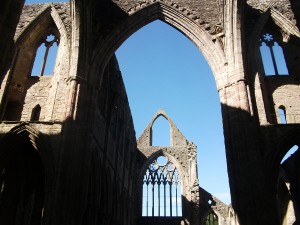Tintern Abbey is a major tourist attraction in southeast Wales. Will and I saw directional signs for it on the highway while driving to Wales from Britain. Tour buses visit. The abbey is a ruin, so I didn’t how much there’d be to see when we went. But, I wanted to go. At university, I’d studied Wordsworth’s famous poem “Tintern Abbey.” What I’d remembered about it, was that he’d visited the abbey with his younger sister and viewed it fresh through her new eyes.
In preparation for the trip, I re-read the poem. It helped that the copy I had was in a book I’d bought years ago second-hand. The original owner had obviously used it as a student. Her scribbled note in the margins deciphered some of the poem’s meaning. Among other things, it’s a religious poem. Wordsworth talks of seeing god in nature and how this sustains him through life’s difficult, depressing and dreary times.
We went to Tintern Abby on a morning that was crystal clear blue. Few other tourists were there. The adjacent town, while focussed on tourism, was attractive, rather than commercial. Quite a lot of the the abbey’s stonework remains and the site offers details on abbey life.
I’d love to spend a couple of days in Tintern, so I could hike up to a viewpoint overlooking the abbey and see it lit up at night.

Did seeing Tintern Abbey help me better understand Wordsworth’s poem? One thing strikes me now. The poem doesn’t mention the abbey at all, except in the title, the full wording of which is: Lines written a few miles above Tintern Abby, On revisiting the banks of the Wye during a tour, July 13, 1978.
A few miles above … was the poet even viewing the abbey when he composed the poem? His images all relate to nature. I wonder if he used the abbey’s name in the poem’s title to draw a parallel: just as conventionally religious people feel God through religious buidlings, nature was Wordsworth’s church.